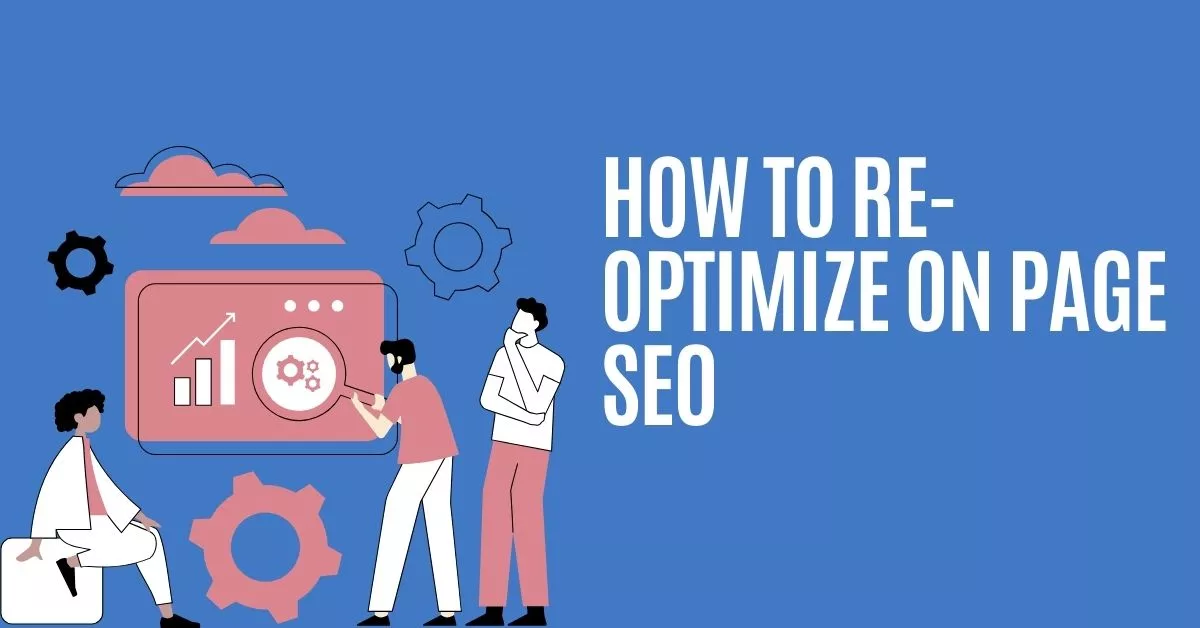In the ever-evolving landscape of digital marketing, staying ahead of the curve is crucial. One of the fundamental aspects of a successful SEO strategy is optimizing on-page content.
While many websites undergo initial optimization, the digital sphere demands continuous adaptation. Re-optimizing on-page content is a strategic approach to ensure your website remains search-engine friendly, user-oriented, and relevant. Let’s delve into the essential steps to re-optimize your on-page content effectively.

Introduction to On-Page Content Optimization
On-page content optimization involves refining various elements within a web page to enhance its visibility and relevance to search engines. This process ensures that your content aligns with users’ search queries, improving your website’s ranking on search engine results pages (SERPs).
Understanding the Importance of Re-Optimizing On-Page Content
Search algorithms, user behavior, and market trends change over time. Re-optimizing allows you to adapt to these shifts, ensuring your content remains valuable, competitive, and engaging.
Conducting a Comprehensive Content Audit
Begin by auditing your existing content. Identify high-performing pages, pages with declining traffic, and those lacking engagement. This analysis forms the basis of your re-optimization strategy.
Keyword Research and Analysis
Update your keyword research. Identify new keywords and phrases relevant to your content. Focus on long-tail keywords and user intent. Tools like Google Keyword Planner and SEMrush can aid in this process.
Crafting Compelling Meta Titles and Descriptions
Meta titles and descriptions are your content’s first impression. Create compelling and concise meta titles (under 60 characters) and descriptions (under 160 characters) that encourage clicks and accurately represent the content.
Optimizing Heading Tags (H1, H2, H3)
Heading tags structure your content. Ensure each page has a single H1 tag representing the main topic. Use H2 and H3 tags to organize subtopics. Headings enhance readability and signal content hierarchy to search engines.
Improving Content Readability and User Experience
Utilize short sentences, bullet points, and concise paragraphs. Break down complex ideas into digestible segments. Engage readers with compelling language and relatable examples.
Utilizing Multimedia Elements
Enhance content appeal with multimedia elements like images, videos, infographics, and charts. Optimize multimedia files for faster loading times. Multimedia not only enriches user experience but also reduces bounce rates.
Internal and External Linking Strategies
Integrate internal links to connect relevant pages within your website, improving navigation and user engagement. External links to authoritative sources enhance content credibility and provide additional context.
Mobile Optimization for On-Page Content
With the rise of mobile users, ensure your content is mobile-responsive. Test your website’s mobile-friendliness using Google’s Mobile-Friendly Test tool and address any issues.
Monitoring and Analyzing Performance
Implement tools like Google Analytics to monitor the performance of re-optimized pages. Track metrics such as bounce rate, dwell time, and conversion rates. Analyze this data to refine your strategy further.
Common Mistakes to Avoid
Avoid keyword stuffing, excessive internal linking, poor quality multimedia, and neglecting mobile optimization. These common mistakes can adversely affect user experience and SEO.

Terminal Words
Re-optimizing on-page content is not merely a task but an ongoing strategy. By adapting to the evolving digital landscape, your website can maintain high visibility, engage users effectively, and achieve sustainable SEO success.
More related posts-
- How to Find Competitor Backlinks: Unlocking the Power of Backlinks for SEO Success.
- 5 Top SEO Content Optimization Tools To Gain Authority in 2023.
FAQs on On-Page Content Optimization
Q1: How often should I re-optimize my on-page content?
It’s advisable to conduct a content audit every six months and re-optimize pages as needed based on performance data.
Q2: Can re-optimizing old blog posts boost my website’s traffic?
Yes, updating and re-optimizing old blog posts can revive their visibility, attracting new readers and improving SEO.
Q3: Should I remove underperforming content during re-optimization?
Consider updating underperforming content before removal. Revise, add value, and optimize. Removing content should be a last resort.
Q4: How does multimedia content impact SEO?
Multimedia elements enhance user engagement. Optimized images and videos can improve page load speed, positively influencing SEO.
Q5: Is user experience important for SEO?
Yes, user experience, including readability, navigation, and mobile-friendliness, significantly impacts SEO. Search engines prioritize user-friendly websites.
In conclusion, re-optimizing on-page content is not just a strategy it’s a commitment to providing valuable, relevant, and engaging content to your audience. By continuously refining your website’s content, you ensure its resilience in the ever-changing digital landscape.
